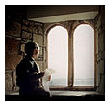
Alpha and Omega are also numbers (4)
Posted by Moderator on Apr 14, 2011 in Mathing | 0 commentsIt’s not particularly difficult to write in numerical literary style. The last three posts in this series were about the significance of the number 496, so naturally they were all 496 words long. It’s as simple as that to make a start.
One day, I’d like to emulate my hero—the author of the fourteenth century poem, Sir Gawain and the Green Knight—but I’ve a very long way to go before I reach the exalted heights of numerical artifice he achieved.
Numerical literary style has its detractors. They come in various ilks. Some critics agree that some ancient texts show a mathematical architecture, but think the motive is numerological. Others simply deny outright that any premeditated arithmetic design exists, preferring to explain away structural details as scribal error. ‘Why would anyone,’ they scoff, ‘mix words and numbers? Why would anyone restrict the creative impulse by confining themselves to a rigid mathematical framework?’
I’d like to try these questions on a Japanese master of haiku, the 17-syllable poem of three lines in a 5-7-5 pattern. Behind the blank inscrutable stare I’d get, I’m sure there’d be the incredulous thought: ‘Don’t you get it? A true craftsman doesn’t find strict form a restraint, but freedom.’
The critics’ question betrays a cultural bias towards a postmodern understanding of creativity, the ‘art for art’s sake’ free-of-all-constraint school of thought that only arose in the twentieth century.
Numerical literary form, arithmetic metaphor, Biblical style, mathematical motif—it doesn’t matter what name it goes by, it’s a fusion of word and number almost as old as literature itself. In this type of story-telling, scenes are constructed to reflect any numbers (or numerical allusions) in the text. For instance, in John’s gospel, there’s an interlude where Jesus heals a man paralysed for 38 years. As MJJ Menken has shown in Numerical Literary Techniques in John – The Fourth Evangelist’s Use of Numbers of Words and Syllables, the word/syllable/letter count of the story is based on multiples of 38.
As mentioned previously, amongst the most important structural numbers writers once utilised were the triangular numbers. They are: 1, 3, 6, 10, 15, 21, 28, 36, 45, 55, 66, 78, 91, 105, 120, 136, 153 and so on. The 31st number in this sequence is 496, the defining number of John’s prologue and epilogue.
As Youngblood has said: ‘Flagrant abuse of various forms of numerology, including especially gematria, should not be permitted to blind us to the undoubted use of numbers in a figurative sense or of numbers as a literary device in the Bible (as well as elsewhere in the ancient world.)’
Given this comment, I have to ask: is there anything inherently special about 31 which would be an additional reason for John to choose the 31st triangular number to convince his readers of the Lordship of Christ?
Now in Hebrew, numbers and letters aren’t separate. 31 is composed of aleph-lamed, making el, Lord God. Immanuel plus Lord God: surely an irresistible combination.

